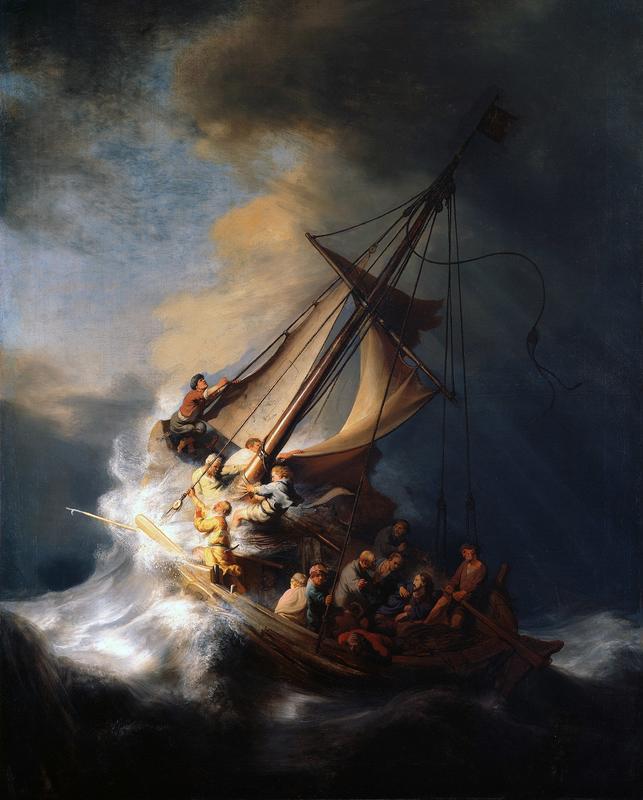Christ in the Storm on the Sea of Galilee was based on the Bible story of the calming of the storm, located in the three Synoptic Gospels Matthew, Mark, and Luke.
Basically Jesus was taking a nap after a long day of preaching, performing miracles, healing the sick, and being chased down by the authorities while he and the disciples were on a boat, crossing the sea of Galilee. While he is asleep, there is a storm, and the disciples are freaking out (which is a big deal since some of them fish for a living and thus are men of the sea). They run to Jesus and say “Master, master, we are perishing!” Jesus, having just woken up from his peaceful slumber, raises his hand to rebuke the wind and waves to calm the sea and turns to his disciples to deliver his signature line, “where is your faith?” This is basically the entirety of the gospels–the disciples freaking out, Jesus performs a miracle and asks them where their faith is, and then they stand in awe like they’ve never seen Jesus perform a miracle. This story is often drawn in parallel with Jesus’ later walk on water, in which Jesus gets Peter, one of the apostles and later founder of the Catholic church, to walk on water as a test of faith. These stories can be seen as a test of faith, to which us all-too-mortal humans (except Peter) are found lacking.
Rembrandt painted this during a time in which he was mostly working on commissioned portraits. He had painted a few history paintings before, but this piece was a cornerstone for him to receive prestigious commissions. In this painting, he draws some of its compositional elements from his predecessor, Rubens, who used a diagonal composition to heighten the drama in The Rising of the Cross and his very own rendition of the gospel story, Christ on the Sea of Galilee. He chose a high vantage point to allow for more space to capture the dramatic waves and the motion of the ships.
He was not as concerned with the accuracy of the piece, rather choosing his methods for depiction based on poetic effect. He based his ship off a hoeker, or a small Dutch fishing vessel, and defying physics by making its mast unnaturally heavy to create a theatrical tilt and a loose masthead flying in the wind.
This painting was acquired by Isabella Stewart Gardner, socialite and art collector, who founded the Isabella Stewart Gardner Museum in Boston once her personal art collection grew too big for her humble mansion in Back Bay. To make sure that it maintained her own personal aesthetic, she also included a clause that if any of the trustees changed the art, the whole museum would be turned over to Harvard for liquidation. However, the museum was looted and due to this stipulation the untouched frames of the stolen artworks hang empty.
Accounts of the event seems straight out of the plot of a heist film (perhaps a properly ocean-themed addition to the Ocean’s franchise?). On March 18, 1990, two men dressed in stolen police uniforms arrived at the museum, handcuffing the museum security guards and wrapping their heads in duct tape. They proceeded to steal 13 objects, including Christ in the Storm on the Sea of Galilee, valued at over $500 million, making it the largest property theft in U. S. history. The whole event took approximately 90 minutes. These stolen objects are yet to be found, but many false sightings have been reported.
In 1997, the Boston Herald reported Thomas Mashberg was driven to a warehouse in the middle of the night and permitted to view the alleged painting by flashlight and given a vial of paint chips to confirm its authenticity. The paint chips were found to be fragments of a Dutch painting, but not the seascape.


















Who was the first owner of this painting